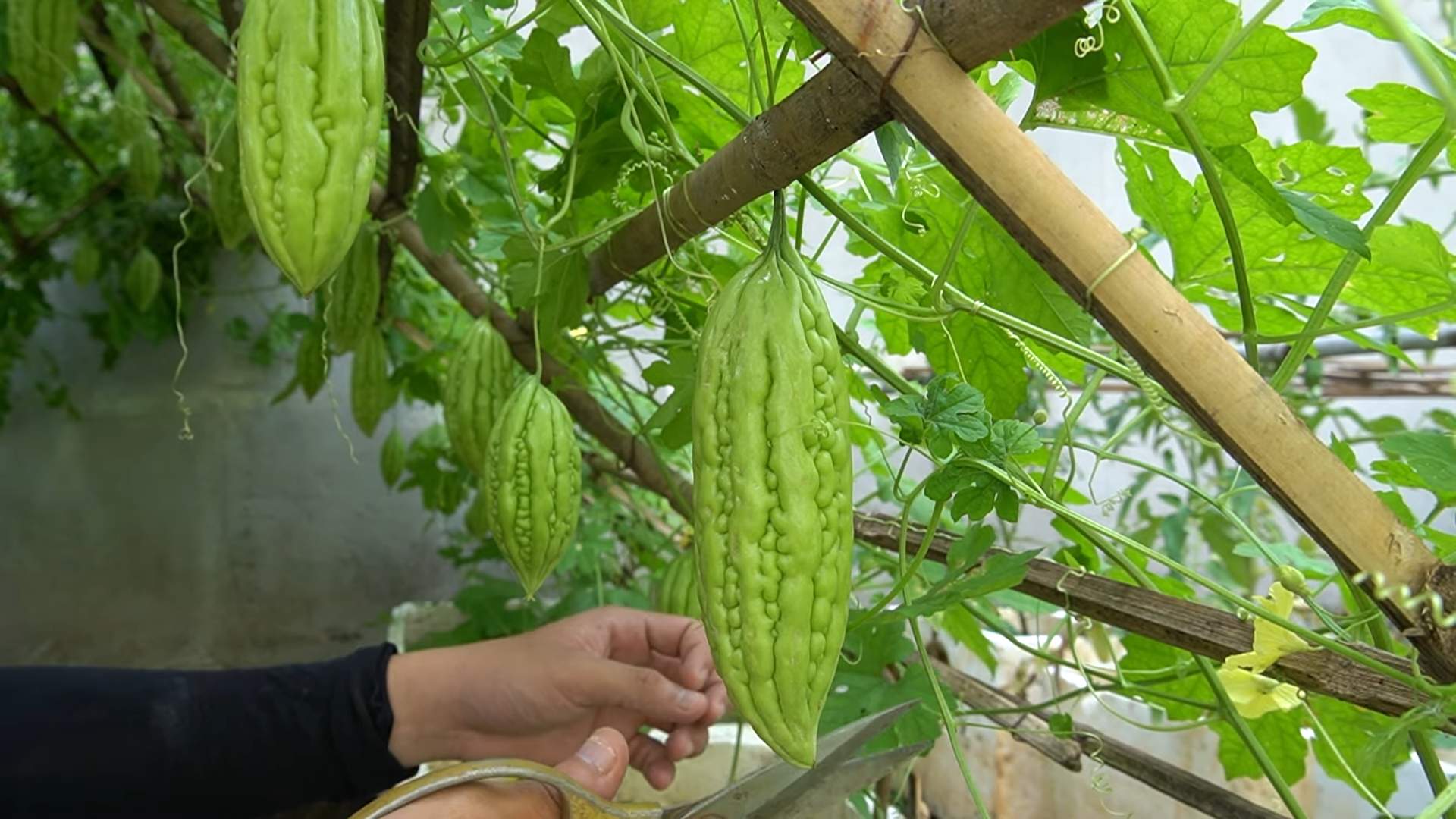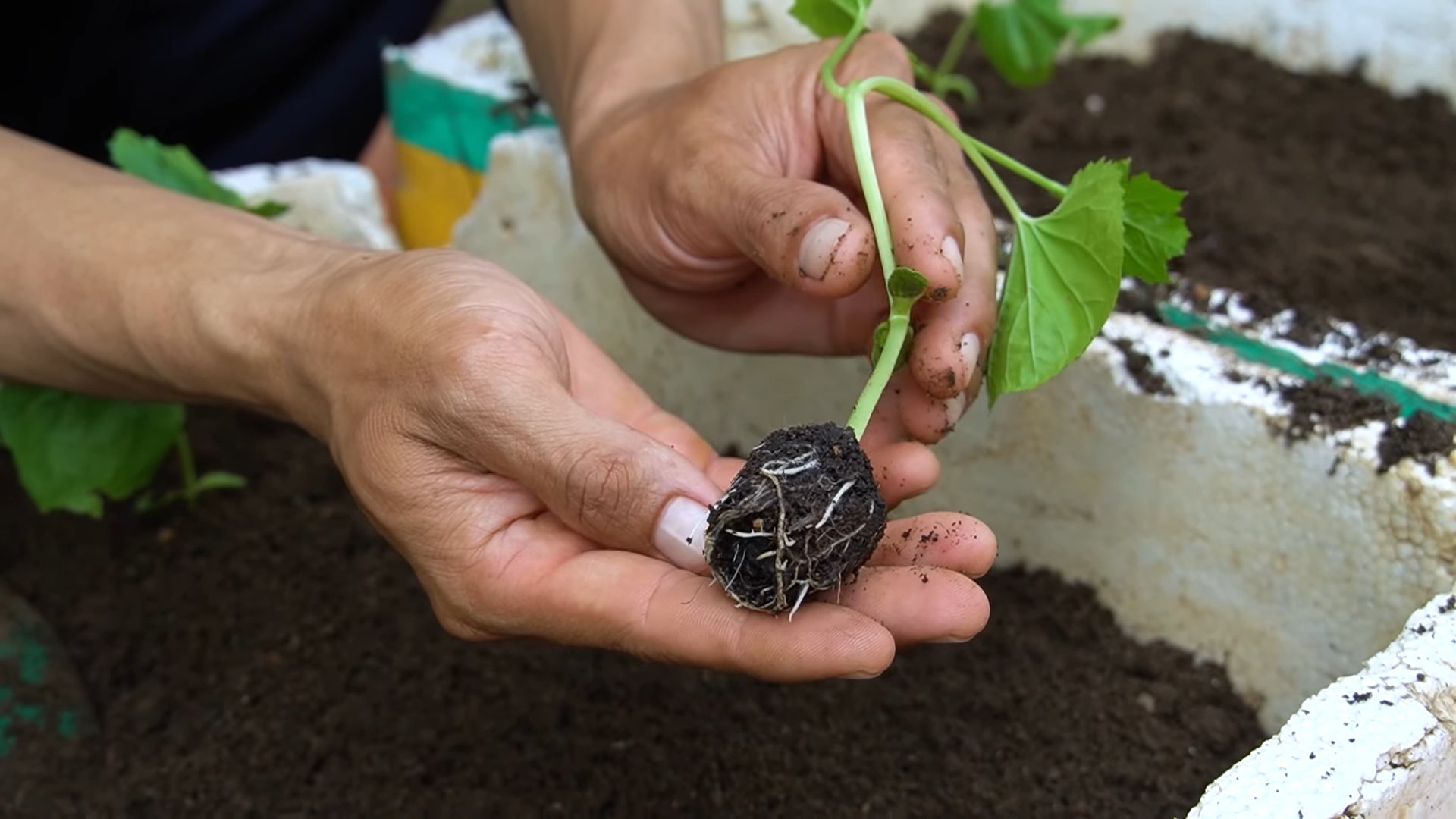Bitter Gourd Growing Success is within your reach, even if you’ve struggled in the past! Have you ever dreamt of harvesting your own vibrant, knobbly bitter gourds, only to be met with stunted growth, yellowing leaves, or a disappointing lack of fruit? I know the feeling! Many gardeners find this unique vegetable a bit challenging, but trust me, with the right tricks and a little DIY ingenuity, you can unlock the secrets to a bountiful harvest.
Bitter gourd, also known as bitter melon or karela, has a rich history, deeply rooted in Asian cuisine and traditional medicine for centuries. From stir-fries to medicinal teas, its distinctive bitter flavor is prized for its health benefits and culinary versatility. But beyond its cultural significance, growing your own bitter gourd offers a sense of accomplishment and the satisfaction of knowing exactly where your food comes from.
Why do you need these DIY tricks and hacks? Because achieving bitter gourd growing success isn’t just about planting a seed and hoping for the best. It’s about understanding the plant’s specific needs – its love for warmth, its thirst for well-drained soil, and its climbing nature. This article is packed with practical, easy-to-follow DIY solutions that will help you overcome common challenges, optimize your growing conditions, and finally enjoy a thriving bitter gourd patch. Let’s get started and turn your gardening dreams into a delicious reality!

Unlock the Secrets to Growing Bitter Gourd Like a Pro!
Hey there, fellow gardening enthusiasts! Are you ready to tackle a slightly challenging, but incredibly rewarding, vegetable? I’m talking about bitter gourd, also known as bitter melon! Don’t let the name scare you. With the right techniques, you can cultivate a thriving bitter gourd patch and enjoy its unique flavor and health benefits. I’m going to walk you through everything I’ve learned to help you achieve bitter gourd growing success.
Choosing the Right Variety and Starting Seeds
First things first, let’s talk about variety. There are several types of bitter gourd, varying in size, shape, and bitterness. Some popular choices include:
* Long Green: A classic variety, known for its elongated shape and moderate bitterness.
* White Pearl: Smaller and rounder, with a slightly milder flavor.
* Chinese Bitter Gourd: Often longer and thinner than other varieties.
I personally prefer the Long Green variety because it’s readily available and produces a good yield. Once you’ve chosen your variety, it’s time to start the seeds. Bitter gourd seeds have a tough outer shell, so scarification is key to successful germination.
Here’s how I do it:
1. Scarify the Seeds: Gently rub the seeds with sandpaper or nick them with a knife. Be careful not to damage the inner part of the seed! This helps water penetrate the seed coat.
2. Soak the Seeds: Soak the scarified seeds in warm water for 24 hours. This further softens the seed coat and encourages germination.
3. Prepare Seed Trays or Pots: Fill seed trays or small pots with a well-draining potting mix. I like to use a mix of coco coir, perlite, and vermicompost.
4. Sow the Seeds: Plant the seeds about 1/2 inch deep in the potting mix.
5. Water Gently: Water the soil gently to avoid disturbing the seeds.
6. Provide Warmth: Bitter gourd seeds need warmth to germinate. Place the seed trays or pots in a warm location, ideally between 75-85°F (24-29°C). A heat mat can be helpful if you live in a cooler climate.
7. Maintain Moisture: Keep the soil consistently moist, but not waterlogged.
8. Wait for Germination: Germination usually takes about 7-14 days.
Preparing the Garden Bed and Transplanting Seedlings
While your seeds are germinating, it’s time to prepare the garden bed. Bitter gourd needs a sunny location with well-drained soil.
Here’s what I do to get my garden bed ready:
1. Choose a Sunny Location: Select a spot in your garden that receives at least 6-8 hours of direct sunlight per day.
2. Amend the Soil: Bitter gourd thrives in rich, well-drained soil. Amend the soil with plenty of compost or well-rotted manure. This improves soil fertility and drainage.
3. Check the Soil pH: Bitter gourd prefers a slightly acidic to neutral soil pH (6.0-7.0). You can test your soil pH using a soil testing kit. If your soil is too alkaline, you can amend it with sulfur.
4. Build a Trellis: Bitter gourd is a vine, so it needs a trellis or other support structure to climb on. You can use a sturdy trellis, fence, or even a pergola. I personally use a simple bamboo trellis that I built myself.
5. Prepare Planting Holes: Once the seedlings have developed a few true leaves (usually after 3-4 weeks), they’re ready to be transplanted. Dig planting holes that are slightly larger than the root balls of the seedlings.
Transplanting Time! Follow these steps:
1. Gently Remove Seedlings: Carefully remove the seedlings from the seed trays or pots, being careful not to damage the roots.
2. Plant Seedlings: Place the seedlings in the planting holes and gently backfill with soil.
3. Water Thoroughly: Water the seedlings thoroughly after transplanting.
4. Mulch Around Plants: Apply a layer of mulch around the plants to help retain moisture and suppress weeds. I like to use straw or wood chips.
5. Train the Vines: As the vines grow, gently train them to climb the trellis. You can use plant ties or twine to secure the vines to the trellis.
Caring for Your Bitter Gourd Plants
Once your bitter gourd plants are established, it’s important to provide them with proper care to ensure a good harvest.
Here’s my care routine:
1. Watering: Water regularly, especially during hot, dry weather. Bitter gourd needs consistent moisture, but avoid overwatering, which can lead to root rot. I usually water deeply 2-3 times a week, depending on the weather.
2. Fertilizing: Fertilize every 2-3 weeks with a balanced fertilizer. I like to use a liquid fertilizer diluted to half strength. You can also use compost tea or fish emulsion.
3. Pruning: Prune the vines to encourage branching and fruit production. Remove any dead or yellowing leaves. You can also pinch off the tips of the vines to encourage lateral growth.
4. Pest and Disease Control: Keep an eye out for pests and diseases. Common pests of bitter gourd include aphids, spider mites, and squash bugs. Common diseases include powdery mildew and downy mildew. I prefer to use organic pest and disease control methods, such as neem oil, insecticidal soap, and copper fungicide.
5. Pollination: Bitter gourd flowers are usually pollinated by insects. However, if you’re not seeing a lot of fruit set, you may need to hand-pollinate the flowers. To hand-pollinate, use a small paintbrush to transfer pollen from the male flowers to the female flowers. Female flowers have a small fruit behind the flower, while male flowers do not.
Harvesting and Enjoying Your Bitter Gourd
Bitter gourd is usually ready to harvest about 2-3 months after planting. The fruits are best harvested when they are still green and slightly immature.
Here’s how I harvest my bitter gourd:
1. Check for Maturity: Look for fruits that are firm and green, with a slightly waxy coating.
2. Cut the Fruit: Use a sharp knife or pruning shears to cut the fruit from the vine. Leave a small stem attached to the fruit.
3. Harvest Regularly: Harvest the fruits regularly to encourage continued production.
Now, what to do with all that bitter gourd?
Bitter gourd can be used in a variety of dishes. It’s often stir-fried, stuffed, or used in soups and stews. The bitterness can be reduced by soaking the sliced gourd in salt water for about 30 minutes before cooking. I personally love it in a stir-fry with eggs and tofu.
Here are a few tips for reducing bitterness:
* Soak in Salt Water: As mentioned before, soaking sliced bitter gourd in salt water helps draw out the bitterness.
* Blanching: Blanching the sliced gourd in boiling water for a few minutes can also help reduce bitterness.
* Remove the Seeds and Pith: The seeds and pith (the white, spongy part inside the gourd) are the most bitter parts. Remove them before cooking.
* Pair with Strong Flavors: Pairing bitter gourd with strong flavors like garlic, ginger, and chili can help balance the bitterness.
Troubleshooting Common Problems
Even with the best care, you may encounter some problems while growing bitter gourd. Here are a few common issues and how to address them:
* Poor Germination: If your seeds aren’t germinating, make sure they are warm enough and have enough moisture. Also, ensure you scarified them properly.
* Yellowing Leaves: Yellowing leaves can be a sign of overwatering, nutrient deficiency, or disease. Check the soil moisture and fertilize if necessary. If you suspect a disease, treat with an appropriate fungicide.
* Lack of Fruit Set: If your plants are flowering but not producing fruit, it could be due to poor pollination. Try hand-pollinating the flowers.
* Pest Infestations: Regularly inspect your plants for pests and treat them promptly with organic pest control methods.
Saving Seeds for Next Year
If you want to save seeds from your bitter gourd plants for next year, allow a few fruits to mature fully on the vine. The fruits will turn orange or yellow and become very soft.
Here’s how I save my seeds:
1. Harvest Mature Fruits: Harvest the fully mature fruits.
2. Extract the Seeds: Cut open the fruits and scoop out the seeds.
3. Clean the Seeds: Wash the seeds thoroughly to remove any pulp.
4. Dry the Seeds:

Conclusion
So, there you have it! Mastering the art of growing bitter gourd doesn’t have to be a bitter experience. By implementing these simple yet effective DIY tricks, you’re setting yourself up for a bountiful harvest of this incredibly nutritious and versatile vegetable. We’ve shown you how to optimize your soil, provide the perfect support system, and combat common pests, all without breaking the bank.
Why is this a must-try? Because growing your own bitter gourd allows you to control the entire process, ensuring you’re consuming a product free from harmful chemicals and pesticides. Plus, there’s an undeniable satisfaction in nurturing a plant from seed to table. Imagine the pride you’ll feel serving up a delicious bitter gourd dish made with ingredients you grew yourself!
But the journey doesn’t end here. Feel free to experiment with different varieties of bitter gourd. Some are more compact and suitable for container gardening, while others boast unique flavors and textures. Consider adding companion plants like beans or marigolds to your garden to further enhance growth and deter pests. You can also explore different trellising methods to find what works best for your space and the specific variety you’re growing. Perhaps you’ll discover that vertical gardening with repurposed materials is the ideal solution for your small balcony. Or maybe you’ll find that a simple bamboo structure provides the perfect support for your sprawling vines.
Don’t be afraid to get creative with your approach to growing bitter gourd. The beauty of gardening lies in the constant learning and adaptation. And remember, even experienced gardeners face challenges. The key is to stay persistent, observe your plants closely, and adjust your methods as needed.
We are confident that with these DIY tricks, you’ll be well on your way to enjoying a thriving bitter gourd crop. Now it’s your turn to get your hands dirty! We wholeheartedly encourage you to try these techniques and witness the difference they can make.
Once you’ve embarked on your bitter gourd growing adventure, we’d love to hear about your experiences. Share your successes, your challenges, and any unique tips you’ve discovered along the way. Let’s build a community of passionate bitter gourd growers, sharing knowledge and inspiring each other to achieve even greater success. Post your photos, stories, and questions in the comments section below. Let’s cultivate a thriving community of gardeners who are passionate about growing their own food, starting with the amazing and often misunderstood bitter gourd. Happy gardening!
Frequently Asked Questions (FAQ)
What is the best time of year to plant bitter gourd?
The ideal time to plant bitter gourd is during the late spring or early summer, after the last frost has passed and the soil has warmed up. Bitter gourd thrives in warm weather and requires a long growing season of at least 90-120 days. In warmer climates, you may be able to plant a second crop in late summer for a fall harvest. Check your local climate data and planting guides for specific recommendations based on your region. Starting seeds indoors 4-6 weeks before the last expected frost can give you a head start on the growing season.
How much sunlight does bitter gourd need?
Bitter gourd requires at least 6-8 hours of direct sunlight per day to thrive. Choose a planting location that receives ample sunlight throughout the day. If you’re growing bitter gourd in containers, make sure to place them in a sunny spot. Insufficient sunlight can lead to stunted growth, reduced flowering, and smaller, less flavorful fruits.
What type of soil is best for growing bitter gourd?
Bitter gourd prefers well-drained, fertile soil that is rich in organic matter. The ideal soil pH is between 6.0 and 7.0. Before planting, amend the soil with compost, aged manure, or other organic materials to improve drainage, fertility, and water retention. Avoid heavy clay soils, as they can become waterlogged and inhibit root growth. If you have clay soil, consider growing bitter gourd in raised beds or containers with a well-draining potting mix.
How often should I water bitter gourd?
Bitter gourd needs consistent moisture, especially during hot weather and fruit development. Water deeply and regularly, aiming to keep the soil consistently moist but not waterlogged. Check the soil moisture regularly by sticking your finger about an inch deep into the soil. If the soil feels dry, it’s time to water. Avoid overhead watering, as it can increase the risk of fungal diseases. Instead, water at the base of the plant or use a soaker hose.
What are some common pests and diseases that affect bitter gourd?
Common pests that can affect bitter gourd include aphids, squash bugs, cucumber beetles, and spider mites. Common diseases include powdery mildew, downy mildew, and fruit rot. Regularly inspect your plants for signs of pests or diseases. Use organic pest control methods, such as insecticidal soap, neem oil, or handpicking, to manage pests. To prevent diseases, ensure good air circulation around the plants, avoid overhead watering, and remove any infected leaves or fruits promptly. Crop rotation can also help to reduce the risk of soilborne diseases.
How do I know when bitter gourd is ready to harvest?
Bitter gourd is typically ready to harvest when the fruits are still green and firm, but have reached their mature size. The exact size will vary depending on the variety. The skin should be smooth and unblemished. If the fruits start to turn yellow or orange, they are overripe and will become more bitter. Use a sharp knife or pruning shears to cut the fruits from the vine, leaving a short stem attached.
Can I grow bitter gourd in containers?
Yes, bitter gourd can be successfully grown in containers, especially if you choose a compact variety. Select a large container that is at least 12 inches in diameter and depth. Use a well-draining potting mix and provide a sturdy trellis or support system for the vines to climb. Water regularly and fertilize every 2-3 weeks with a balanced fertilizer. Make sure the container receives at least 6-8 hours of direct sunlight per day.
How can I reduce the bitterness of bitter gourd?
There are several ways to reduce the bitterness of bitter gourd. One common method is to soak the sliced or chopped bitter gourd in salted water for at least 30 minutes before cooking. This helps to draw out some of the bitter compounds. You can also blanch the bitter gourd in boiling water for a few minutes before cooking. Another technique is to remove the seeds and pith from the center of the fruit, as these are the most bitter parts. Cooking bitter gourd with acidic ingredients, such as vinegar or lemon juice, can also help to balance the bitterness.
What are some ways to use bitter gourd in cooking?
Bitter gourd can be used in a variety of dishes, both savory and sweet. It is commonly stir-fried, stuffed, curried, or added to soups and stews. In some cultures, it is also juiced or used to make teas. Before cooking, it is important to prepare the bitter gourd properly to reduce its bitterness. Some popular bitter gourd recipes include bitter gourd stir-fry with eggs, stuffed bitter gourd with lentils and spices, and bitter gourd curry with coconut milk.
How can I save seeds from my bitter gourd plants?
To save seeds from your bitter gourd plants, allow a few fruits to fully ripen on the vine until they turn yellow or orange. Once the fruits are ripe, harvest them and scoop out the seeds. Wash the seeds thoroughly to remove any pulp or debris. Spread the seeds out on a paper towel to dry completely. Once the seeds are dry, store them in an airtight container in a cool, dark, and dry place. Properly stored bitter gourd seeds can remain viable for several years.




Leave a Comment